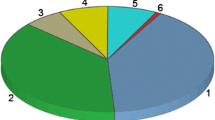Abstract
Purpose
YouTube is a global medium used predominantly by young adults (aged 18–49 years). This study examined the quality of YouTube information regarding ACL injury and reconstruction.
Methods
YouTube was searched on the 13th of June 2015 for “ACL” and “anterior cruciate ligament” with/without associated terms of “injury”, “reconstruction”, and “surgery”. Videos were evaluated by two independent reviewers [EF (Reviewer 1), (Reviewer 2)] using two recognized information scoring systems (Modified DISCERN (MD) 0–5 and JAMA Benchmark 0–4) and an adaptation of a score designed for written ACL information [ACL Specific Score (ASS) 0–25]. The ASS categorized scores as very good (21–25), good (16–20), moderate (11–15), poor (6–10), and very poor (0–5). Number of views/likes/dislikes, animation, and continent of origin and source (e.g., corporate/educational) were recorded. Correlation of video characteristics with number of views was examined using the analysis of variance (ANOVA) model. Agreement between reviewers was assessed by Interclass Correlation Co-efficient (ICC).
Results
Following a filtering process of the 964,770 identified videos, 39 videos were retained. The mean MD score was 2.3 (standard deviation (SD) ±0.9) for Reviewer 1 and 2.2 (SD ±0.9) for Reviewer 2 (ICC = 0.7). The mean JAMA score was 2.5(SD ±0.7) for Reviewer 1 and 2.3 (SD ±0.7) for Reviewer 2 (ICC = 0.8). The mean ASS was 6.3 (SD ±3.5) for Reviewer 1 and 4.6 (SD ±2.9) for Reviewer 2 (ICC = 0.9). Five videos achieved moderate score (13%), while 15 (38%) and 19 (49%) scored as poor and very poor, respectively. There was no correlation between number of views and video quality/video source for any scoring system.
Conclusion
The majority of videos viewed on YouTube regarding ACL injury and treatment are of low quality.



Similar content being viewed by others
References
Garrett WE, Swiontkowski MF, Weinstein JN, Callaghan J, Rosier RN, Berry DJ, Harrast J, Derosa GP (2006) American Board of Orthopaedic Surgery Practice of the Orthopaedic Surgeon: Part-II, certification examination case mix. J Bone Joint Surg Am 88:660–667
Sanders TL, Maradit Kremers H, Bryan AJ, Larson DR, Dahm DL, Levy BA, Stuart MJ, Krych AJ (2016) Incidence of Anterior Cruciate Ligament Tears and Reconstruction: A 21-Year Population-Based Study. Am J Sports Med 44:1502–1507
Pew Research Centre (2015) Social Media Usage: 2005–2015. http://www.pewinternet.org/2015/10/08/social-networking-usage-2005-2015/. Accessed 7 May 2016
Pew Research Centre (2015) 5 facts about online video, for YouTube’s 10th birthday.
YouTube statistics. https://www.youtube.com/yt/press/statistics.html
Cassidy JT, Baker JF (2016) Orthopaedic patient information on the world wide web: an essential review. J Bone Joint Surg Am 98:325–338
Jansen B, Spink A An Analysis of Web Documents Retrieved and Viewed. In: The 9th International Conference on Internet Computing. Las Vegas, Nevada, June 2003 https://faculty.ist.psu.edu/jjansen/academic/pubs/pages_viewed.pdf. Accessed 7 May 2016
Silberg WM, Lundberg GD, Musacchio RA (1997) Assessing, controlling, and assuring the quality of medical information on the Internet: Caveant lector et viewor–Let the reader and viewer beware. JAMA 277:1244–1245
Singh AG, Singh S, Singh PP (2012) YouTube for information on rheumatoid arthritis–a wakeup call? J Rheumatol 39:899–903
Charnock D, Shepperd S, Needham G, Gann R (1999) DISCERN: an instrument for judging the quality of written consumer health information on treatment choices. J Epidemiol Community Health 53:105–111
Bruce-Brand RA, Baker JF, Byrne DP, Hogan NA, McCarthy T (2013) Assessment of the quality and content of information on anterior cruciate ligament reconstruction on the internet. Arthroscopy 29:1095–1100
Madathil KC, Rivera-Rodriguez AJ, Greenstein JS, Gramopadhye AK (2015) Healthcare information on YouTube: a systematic review. Health Informat J 21:173–194
Desai T, Shariff A, Dhingra V, Minhas D, Eure M, Kats M (2013) Is content really king? An objective analysis of the public’s response to medical videos on YouTube. PLoS One 8:e82469
Koller U, Waldstein W, Schatz K-D, Windhager R (2016) YouTube provides irrelevant information for the diagnosis and treatment of hip arthritis. Int Orthop 40:1995–2002
MacLeod MG, Hoppe DJ, Simunovic N, Bhandari M, Philippon MJ, Ayeni OR (2015) YouTube as an information source for femoroacetabular impingement: a systematic review of video content. Arthroscopy 31:136–142
Brooks FM, Lawrence H, Jones A, McCarthy MJH (2014) YouTube™ as a source of patient information for lumbar discectomy. Ann R Coll Surg Engl 96:144–146
Staunton PF, Baker JF, Green J, Devitt A (2015) Online curves: a quality analysis of scoliosis videos on YouTube. Spine 40:1857–1861
Elhassan Y, Sheridan G, Nassiri M, Osman M, Kiely P, Noel J (2015) Discectomy-related information on the internet: does the quality follow the surge? Spine 40:121–125
Nason GJ, Baker, Byrne DP, Noel J, Moore D, Kiely PJ (2012) Scoliosis-Specific Information on the Internet. Spine 37:E1364–E1369
Author information
Authors and Affiliations
Corresponding author
Ethics declarations
Conflict of interest
The authors declare that they have no conflict of interest.
Funding
There is no funding source.
Ethical approval
This article does not contain any studies with human participants or animals performed by any of the authors.
Informed consent
Informed consent was obtained from all individual participants included in the study.
Rights and permissions
About this article
Cite this article
Cassidy, J.T., Fitzgerald, E., Cassidy, E.S. et al. YouTube provides poor information regarding anterior cruciate ligament injury and reconstruction. Knee Surg Sports Traumatol Arthrosc 26, 840–845 (2018). https://doi.org/10.1007/s00167-017-4514-x
Received:
Accepted:
Published:
Issue Date:
DOI: https://doi.org/10.1007/s00167-017-4514-x




